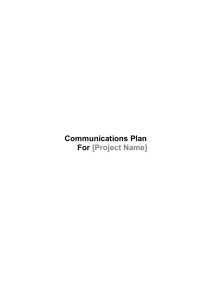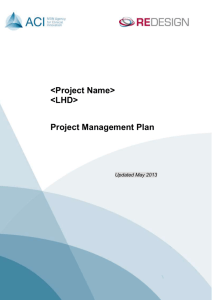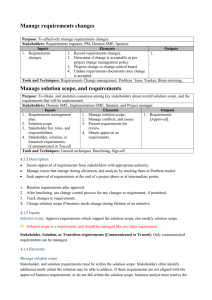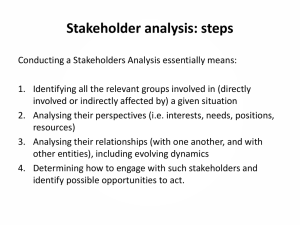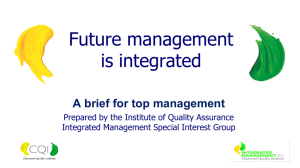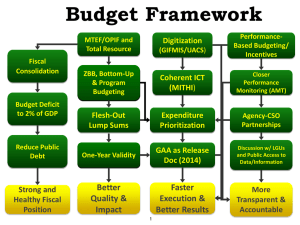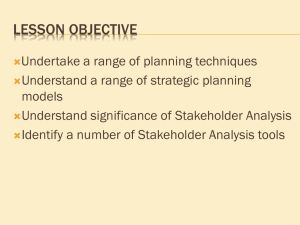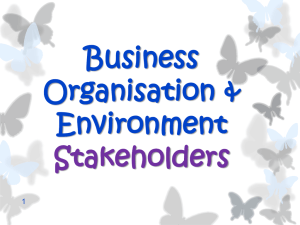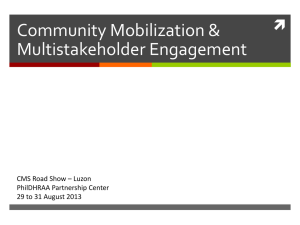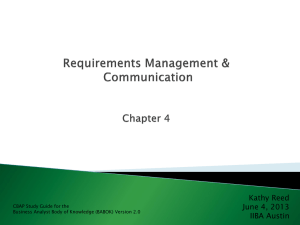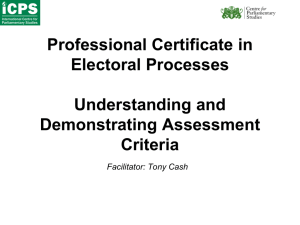the CBAP Study Guide for BABOK Chapter
advertisement
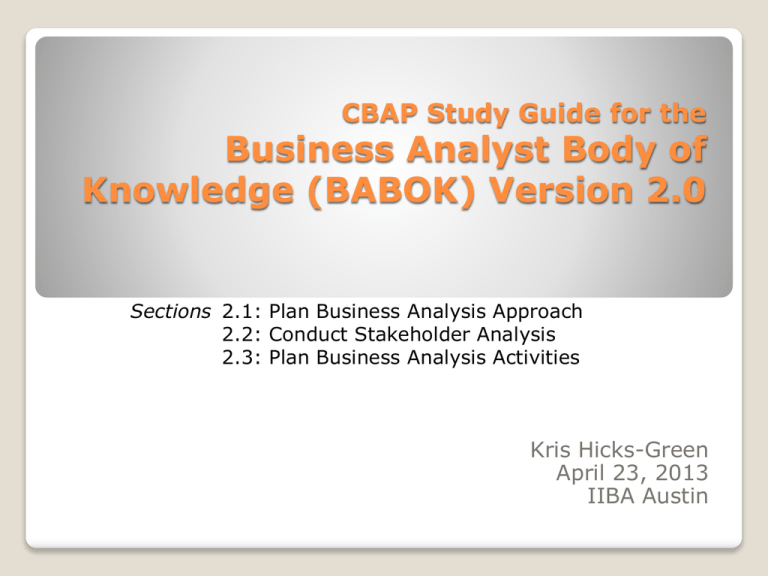
CBAP Study Guide for the Business Analyst Body of Knowledge (BABOK) Version 2.0 Sections 2.1: Plan Business Analysis Approach 2.2: Conduct Stakeholder Analysis 2.3: Plan Business Analysis Activities Kris Hicks-Green April 23, 2013 IIBA Austin Chapter 2 emphasizes BA planning and monitoring as it applies to software application development, but the lessons can be applied to other work as well. Chapter 2 Overview It (and the rest of BABOK) consistently uses the following approach: Also provides info on Elements (factors to plan for); Techniques; Stakeholders Sections 2.1 – 2.3 have four such diagrams: BA Planning and Monitoring (overview); Plan BA Approach; Conduct Stakeholder Analysis; Plan BA Activities Chapter 2 Overview (Cont.) Everything a BA does— the process followed how and when the tasks are performed the techniques used the products that result —can differ by project. To develop an appropriate approach, the BA must understand the organizational process needs and objectives that apply to the project. Chapter 2 Overview (Cont) Inputs to Consider Business Need ◦ Problem/Opportunity Risks Timeframe Expert Judgment ◦ You Stakeholders Ctrs of Comp Other Organizational Process Assets ◦ BA/Process Change/Software Dev Approaches Stakeholder Tools Governance Standards Templates Guidelines Section 2.1: Plan BA Approach Plan-driven (Waterfall) W h y Minimize up-front uncertainty Maximize control Minimize risk W h o Sponsors approve W h e n BA work mostly at beginning or one specific project stage Change-driven (Agile) Exploratory/incremental Rapid delivery Frequent feedback points Project Owner approves List of Req. created early Detail reqs. when ready for dev. What Methodology Fits Input? Plan-driven (Waterfall) H o w Change-driven (Agile) High ceremony, detailed deliverables Limited documentation, may come after product completion Formal approval req’d to advance Define reqs., obtain approval through team interaction Changes occur only when necessary & justified. Changes as “mini projects” Changes integrated into production: prioritized alongside other features Formal, frequently written, predefined communication methods Frequent, informal. Documentation follows implementation to “catch up” What Methodology Fits Input? Project Complexity ◦ ◦ ◦ ◦ ◦ ◦ Number of stakeholders Number of business areas affected Number of business systems affected Amount and nature of risk Uniqueness of requirements Uncertainty of requirements (e.g., new venture vs. accounting project) ◦ Number of technical resources required ◦ Need to maintain solution knowledge over long term Further Approach Considerations Decision Analysis ◦ Rates available methodologies against org needs and objectives Process Modeling ◦ Defines and documents BA approach Structured Walkthrough ◦ Validates a created, selected, or tailored BA approach These are discussed in detail in Chapter 9 Techniques to Determine Approach Customer, Domain SME, End User or Supplier Implementation SME Project Manager Tester Regulator Sponsor Identify Stakeholders The definition of the approach that will be taken for business analysis in a given initiative. It may specify: ◦ ◦ ◦ ◦ ◦ Team roles Deliverables Analysis techniques Timing & frequency of stakeholder interactions More Output: BA Approach Business Needs Enterprise Architecture ◦ Org units, incl. roles and relationships, and those units’ interactions, customers, suppliers, responsibilities Organizational Process Assets ◦ Policies and procedures, forms, methodologies, templates, guidelines 2.2: Stakeholder Analysis: Inputs Identification Complexity ◦ Number and variety of direct end users ◦ Number of interfacing business processes and automated systems Attitude Influence ◦ Influence on project, in org, needed for the good of project, with other stakeholders Stakeholder Assessment Elements Brainstorming Interviews Organization Modeling Requirements Workshops These and more are described in detail in Chapter 9 Stakeholder Analysis: Techniques Describes roles of those involved in BA activities: [R]esponsible – Does the work [A]ccountable – The decision maker (limit to one) [C]onsulted – To be consulted prior to work; gives input [I]nformed – To be notified of outcome Change Request Process RACI Executive Sponsor A Business Analyst R Project Manager C Developer C Tester I Trainer I Technique: RACI Matrix Diagrams that depict the relationship of stakeholders to the solution and one another. Technique: Stakeholder Map Determines activities that must be performed and deliverables to be produced Defines scope Estimates effort required Identifies management tools to measure progress 2.3: Plan BA Activities Plan incrementally or on a “rolling wave” basis. (Plan-driven Projects) ◦ High-level plan for long term ◦ Detailed plan for near-term activities ◦ Communicate need (and method) for long-term plans to change as more is known Follow a well-defined, time limited process for developing requirements. Limit each iteration to work that can be completed in time allotted. (Change-driven Projects) To Accommodate Change BA Approach BA Performance Assessment ◦ Prior experience Organizational Process Assets ◦ May mandate particular deliverables ◦ Lessons learned from previous efforts Stakeholder List, Roles, Responsibilities Plan BA Activities: Input Geographic Distribution of Stakeholders Type of Project or Initiative Deliverables Determine Activities (Work Breakdown Structure) Optional: Assumptions, Dependencies, Milestones Plan BA Activities: Elements Estimation ◦ Typically developed in conjunction with PM and other team members ◦ Makes use of org. methodology and templates Functional Decomposition ◦ Breaks down the tasks in a project or product to facilitate understanding of the work to enable estimation Risk Analysis ◦ Identify risks that might impact the business analysis plans Plan BA Activities: Techniques Customer, Domain SME, End User, Suppliers Implementation SME Operational Support Project Manager Tester Sponsor ◦ Likely the major source of requirements ◦ May need assistance understanding process, goals ◦ Availability is crucial ◦ Can participate to better learn stakeholder needs, deliverable form and schedule ◦ May use BA deliverables for planning support work ◦ BA Plan integrated with overall project plan ◦ Can participate to learn deliverable form and schedule ◦ Must participate in approval of BA deliverables Plan BA Activities: Stakeholders Business Analysis Plan(s). May include: ◦ ◦ ◦ ◦ ◦ Scope of Work Work Breakdown Structure Activity List Estimates for each activity and task How and when plan should be changed Plan BA Activities: Output 18% of the CBAP exam questions are drawn from BA Planning and Monitoring Section. Tables and diagrams are particularly important to remember (see pps. 17, 19, 25, 30, 33). Good to Know!
